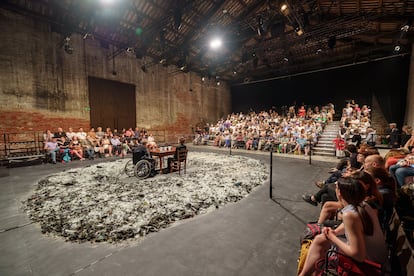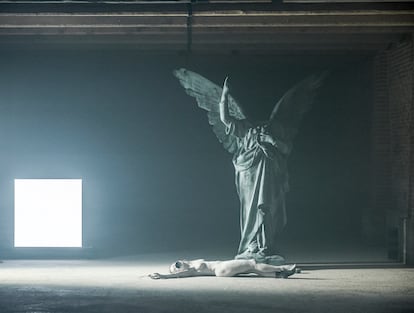There’s a Willem Dafoe for every viewer. For most, he’s the Hollywood actor who starred in blockbusters like Platoon, Mississippi Burning, and The Last Temptation of Christ. Some identify him with the supervillain Norman Osborn in the Spider-Man saga. Others associate him with the art-house films of David Lynch, Lars von Trier, Sean Baker, and Yorgos Lanthimos. Some may even have come across his avatar in the video game Beyond: Two Souls. But not as many know that he co-founded one of the most influential companies in American experimental theater, The Wooster Group, born in the effervescent New York scene of the 1970s and still active today. He has also worked with such prominent directors as Romeo Castellucci and Bob Wilson. In Spain, he was seen in 2012 in a powerful operatic production at the Royal Theater in Madrid, The Life and Death of Marina Abramovic, created by Wilson and Abramovic, with music by Antony and William Basinski.
But the chameleon-like American actor’s myriad faces still contain surprises. At 69, Dafoe has been named artistic director of the theater section of the Venice Biennale (May 31 to June 15), one of the great events of the European avant-garde scene. Added to this is the excitement generated by his participation as a performer in one of the festival’s shows, No Title (An Experiment), which premiered last Friday. Dafoe has been a familiar presence in Italy since he moved to Rome two decades ago following his marriage to actress and director Giada Colagrande, but it’s unusual to see such a charismatic movie star performing in a production that, from the very lack of title, forewarns of its departure from commercial norms. He’s as magnetic up close as he is on screen: in a second, he can go from the most rigid expression to giving you a smile full of affection.

The play he presented in Venice is a love letter to theatrical experimentation as a driving force of artistic innovation, even if it doesn’t attract masses of viewers like Hollywood films. “In New York in the 1960s and 1970s, much of the innovation came from non-professionals and marginalized communities. Since then, those groups have been absorbed into the mainstream. Similarly, the avant-garde recognized theater as a complete art form. Performance, visual arts, architecture, film, new technologies, music, and dance came together to create works that weren’t necessarily based on literature or narrative. Theater was redefined,” Dafoe explains in an interview prior to the premiere, which EL PAÍS attended at the invitation of the Biennale.
No Title (An experiment) is based on a meeting Dafoe had with Richard Foreman, a leading exponent of American experimental playwriting, shortly before his death last January. Foreman showed him a deck of cards on which he had jotted down loose sentences and asked him to read them at random. When they finished, they shuffled the deck and started over. That’s what the play is about. Dafoe and actress Simonetta Solder repeat that chance conversation three times (twice in English and once in Italian) in a quadrilateral enclosed by ropes like a boxing ring. Strikingly, the floor is littered with broken glass: “Act as if the stage were covered in broken glass,” Foreman told Dafoe. There are philosophical reflections, common expressions, aphorisms, poetic sayings, a few absurdities, and even grunts. Sometimes they seem like snippets of conversations caught on the fly: open the window, continue on the road, cross your fingers, one more day is one less day, why not now, remember to call, love me, yesterday is tomorrow. But at times, the pieces fit together so well that you’d think they were actually having a conversation.

Is this the kind of theater Dafoe loves most? He answers: “Not necessarily. I also like highly composed, choreographed, and designed performances. Theater, by its very nature, is unpredictable and unrepeatable, even when it’s technically very precise. This work is both a tribute to Foreman and a very specific experiment in the nature of language, its ability to construct worlds and perceptions through words.”
The Dafoe Biennale is imbued with this way of understanding theater. The program traces an overview of the avant-garde from the innovative masters of the 1970s to the biggest names on the scene today. Starting with his former company, The Wooster Group, which opened the festival on May 31 with a revival of one of its most celebrated productions, Symphony of the Rats, also by Foreman. The show, which premiered in 1988, is a good example of the group’s style, which began using video and all kinds of technology on stage when very few others were doing so. “I remember during one performance, people threw things at us and shouted, ‘Go back to Disneyland!’” Dafoe notes. Not only that, but the production seems visionary: a fictional American president begins to act crazily after suffering a mental breakdown that leads him to believe he’s receiving messages from outer space.
Dafoe has also invited other leading figures from that theatrical generation, many of whom converged at the historic 1975 Biennale, directed by the late Luca Ronconi. Among them is Eugenio Barba, head of the legendary Odin Teatret in Denmark, who presented his latest work on Wednesday. Or Thomas Richards, a direct disciple of the legendary Grotowski, who will close the festival next Sunday. His proposals are no longer as innovative, but their foundations resonate in many current creations. “They created new approaches, methods, languages that help us liberate ourselves today. It’s important to understand the origins of these influences. Otherwise, these refinements of the new theatrical language can easily be corrupted,” he warns.
But not everything can be a given at a festival that has always championed the avant-garde. In addition to a handful of emerging artists, Dafoe has programmed three mainstays of contemporary European theater: German Thomas Ostermeier, Swiss Milo Rau, and Italian Romeo Castellucci.

The most disturbing proposal is undoubtedly Castellucci’s, entitled I mangiatori di patate (The Potato Eaters), like the sinister Van Gogh painting that inspires its esthetic. It is a work conceived specifically for Lazzaretto Vecchio, the deserted island in the Venetian lagoon where plague sufferers were confined between the 15th and 17th centuries. Archaeologists have exhumed 1,500 skeletons in recent years, out of the thousands estimated to remain buried there. Visitors are summoned to a dock to reach the island on a special boat under the luminous Venetian sky, which accentuates the contrast with the dense darkness of the fortified corridors surrounding the site. In these spaces filled with memory, where hunger, cold, and death resound, Castellucci unleashes his powerful scenic cannonball: writhing bodies wrapped in body bags, a furious black wind laden with howls, hoarse whirring, a winged statue, a woman covered in white dust. Emotions surge on the return journey. But the silhouette of Venice in the background reminds us that beauty is also possible.
Sign up for our weekly newsletter to get more English-language news coverage from EL PAÍS USA Edition


